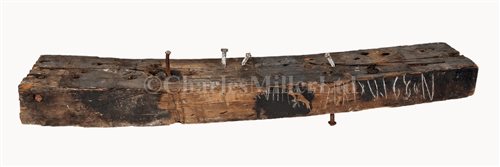3rd Nov, 2015 12:00
Maritime and Scientific Models, Instruments & Art ('Encounter')
50
[M] A SUBSTANTIAL OAK FRAME SECTION FROM H.M.S....
with carpenters rase marks inscribed along one side reading No.39 rr x 1814x X [or] VIIII / I\, with three large iron and alloy pins extruding from the obverse with a single pin on the reverse (old wear, marks, holes etc., rase mark partially rubbed) -- 6 x 76 x 13in. (15 x 193 x 33cm.)
Provenance: H.M.S. Victory, removed between 1922 and 1959; sold to Victory Ltd in 2000 and Victory Oak Ltd, 2006.
Literature: McGowan, A: H.M.S. VICTORY / Her Construction and Restoration, Caxton Editions, 1999, p.93.
A 'rase mark', made using a special rase knife, is a Timber Master's method of instructing the carpenters as to the location of beams that needed to be removed or repaired in refits, thus a ship could generate huge numbers which needed to be put back in the right place. This beam is thought to have come from deep within the main body of the ship from the upper deck area have been decoded "Beam Number 39 (Richard Mosebury) 1814 9 [or] 13 feet above [replaced]", indicating that it was the thirty-ninth beam (in a location known only to the Timber Master), and was originally either nine or thirteen feet in length - the confusion being caused by the 'X' being either the Roman numeral for '10', or a cancelled '1'. The Timber Master responsible was Richard Mosebury - there being no Timber Master using the initials 'rr', it is likely these copy marks were made by an illiterate carpenter. Although this repair took place in 1814, the beam has several witness marks suggesting it's much older and likely to have formed part of the original build.
This lot will be available for viewing at Imperial Road
Condition Report
As described; this beam has also been treated for worm damage and appears stable at the present time.
We are pleased to provide you with a general report of the condition of this property. Since we are not professional conservators or restorers, we urge you to consult with a restorer or conservator of your choice who will be better able to provide a detailed, professional report. Prospective buyers should inspect each lot to satisfy themselves as to condition and must understand that any statement made by Charles Miller Ltd is merely a subjective, qualified opinion. Prospective buyers should also refer to any Important Notices regarding this sale, which are printed in the Sale Catalogue. NOTWITHSTANDING THIS REPORT OR ANY DISCUSSIONS CONCERNING A LOT, ALL LOTS ARE OFFERED AND SOLD “AS IS” IN ACCORDANCE WITH THE CONDITIONS OF BUSINESS PRINTED IN THE SALE CATALOGUE.
with carpenters rase marks inscribed along one side reading No.39 rr x 1814x X [or] VIIII / I\, with three large iron and alloy pins extruding from the obverse with a single pin on the reverse (old wear, marks, holes etc., rase mark partially rubbed) -- 6 x 76 x 13in. (15 x 193 x 33cm.)
Provenance: H.M.S. Victory, removed between 1922 and 1959; sold to Victory Ltd in 2000 and Victory Oak Ltd, 2006.
Literature: McGowan, A: H.M.S. VICTORY / Her Construction and Restoration, Caxton Editions, 1999, p.93.
A 'rase mark', made using a special rase knife, is a Timber Master's method of instructing the carpenters as to the location of beams that needed to be removed or repaired in refits, thus a ship could generate huge numbers which needed to be put back in the right place. This beam is thought to have come from deep within the main body of the ship from the upper deck area have been decoded "Beam Number 39 (Richard Mosebury) 1814 9 [or] 13 feet above [replaced]", indicating that it was the thirty-ninth beam (in a location known only to the Timber Master), and was originally either nine or thirteen feet in length - the confusion being caused by the 'X' being either the Roman numeral for '10', or a cancelled '1'. The Timber Master responsible was Richard Mosebury - there being no Timber Master using the initials 'rr', it is likely these copy marks were made by an illiterate carpenter. Although this repair took place in 1814, the beam has several witness marks suggesting it's much older and likely to have formed part of the original build.
This lot will be available for viewing at Imperial Road
Auction: Maritime and Scientific Models, Instruments & Art ('Encounter'), 3rd Nov, 2015


